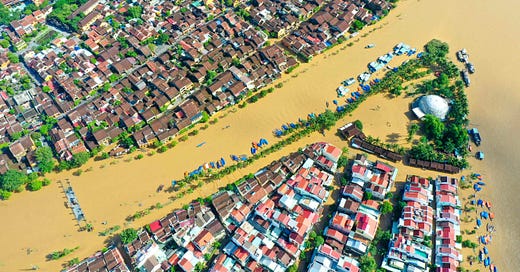There are so many angles from which to look at climate and AI. I’ve mentioned the vast energy and water use that a lot of this technology requires. It’s so unfathomable that, in a search for solutions, I spoke to Keolu Fox — a native Hawaiian geneticist, assistant professor of anthropology at UC San Diego, and co-founder and co-director of the Indigenous Futures Institute — on the podcast about what indigenous futurism could bring: How do we bring the scale and awesome power of nature to bear on technology? What might planet-friendly computing look like as an alternative to the resource-intensive data centers that power most of AI? (Meanwhile, Microsoft recently struck a deal with Three Mile Island to buy energy from the dormant nuclear reactor, which is being brought back online. Google and Amazon are looking to nuclear, too.)
Today, let’s look at AI’s role in climate forecasting. Current weather forecasting relies heavily on complex computer simulations that divide the Earth into grids of atmosphere. In order to make detailed local forecasts, meteorologists rely on high-resolution models that are computationally expensive and take a lot of time to run — sometimes too long to identify rapidly developing storms.
To date, AI models have struggled with predictions at the local level and failed to capture small but important features, like the exact location of heavy rainfall. In August, NVIDIA Research announced that it had developed a generative AI model, CorrDiff — part of its Earth-2 set of software and services — that mimics the detailed forecasts of traditional high-resolution models at a fraction of the computational cost. (NVIDIA claims that CorrDiff slashes the cost by 50x.)
CorrDiff can offer faster updates that are crucial for forecasting events like thunderstorms, flash floods, or typhoons. This means we can better track how and where storms will evolve in the next few hours, which will help improve early warnings. These models can also forecast radar images of storm systems, helping predict how they will grow and change, as well as how features like cold air pools, which can impact storm intensity, will develop.
These faster, more accurate warnings will allow emergency services to issue faster warnings for storms, floods, and other extreme events. When it comes to hurricanes or typhoons, having more detailed and frequent predictions could help improve evacuation plans and resource allocation, potentially saving lives and property.
Beyond day-to-day weather forecasts (and disaster planning), these AI models could also improve our understanding of longer-term climate patterns, helping us better predict how climate change will affect specific regions. As for its own impact on the climate, NVIDIA claims that CorrDiff slashes energy use by 25x per year.
When it comes to AI headlines, we have been awash in news about deepfakes and other sinister uses. Here is a concrete and powerful thing that generative AI is very useful for. Let’s keep the positive applications coming!




